CHINA (17 - Pamir Range)
![]()
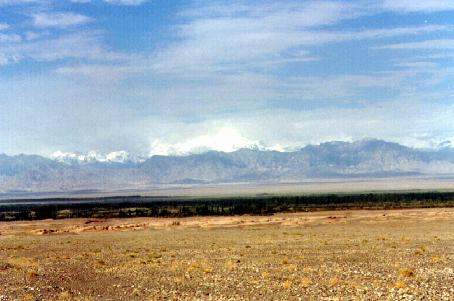
Pamir Range
From Kashgar, I would have loved to go south-west through the Karakoram highway to mysterious Hunza and Gilgit which have fascinated me since I read Kipling's "Kim", Kaye's "Far Pavilions" and similar adventure novels but as I had chosen to go through Kazakstan, that will have to wait for a future trip.
I love mountains so I decided to go south part of the way as
far as the legendary Tashkurgan to have a good look at the Pamir Range which you
can see here on the other side of Ghez river. The well known John Hu organised
the trip for me with Mort and Mary, two middle aged americans who had just spent
a year in Beijing as text correctors for the English language "Chinese
Times".
![]()
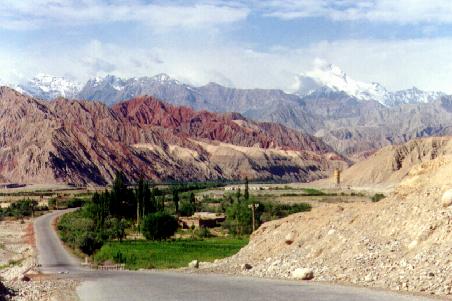
Ghez Oasis
About 120 kms south of Kashgar lies the Ghez Oasis in the foothills of the Pamir Range seen in the background.
![]()
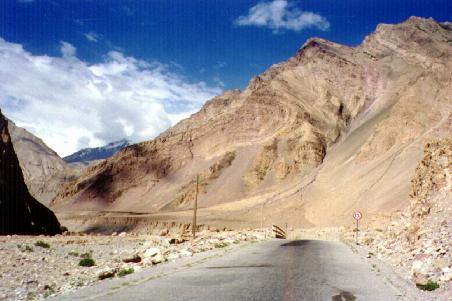
Pamir foothills
Clearly visible on the mountain face ahead is evidence of the intense geological folding suffered by the asian plate as it was compressed and uplifted by the colliding indian plate moving north.
![]()
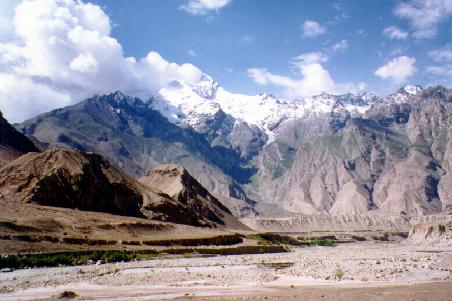
Konghur Shan
The great Kongur Shan rises up to 7719 meters.
![]()

Kyrgyz camp
The border of Tajikistan is just a dozen kms west of here but most nomads in this area are of Kyrgyz origin. Kyrgyzstan is about 200 kms to the north-west but borders never meant much to nomads. Paradoxially, they could move their ger camps 30 kms a day without effort when they used horses but they move much less now that they have trucks!
![]()

Kyrgyz girls
According to these photos, young kyrgyz girls like red to excite the young bulls but choose more sedate colours when they get older.

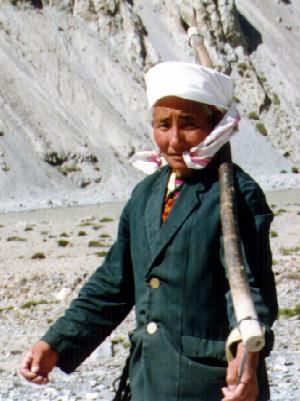
![]()
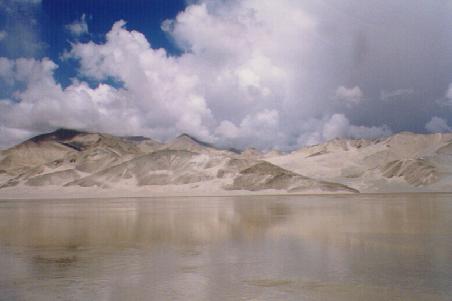
Pamir Range
I have seldom seen anything as beautiful as this mountain lake called Besekh Kul.
![]()
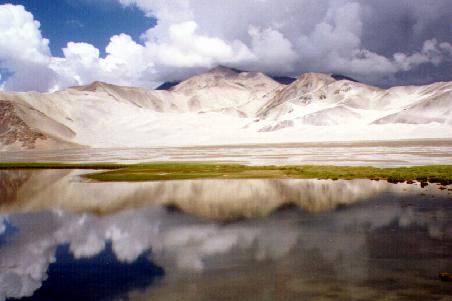
Pamir Range
Shor Kul just next to Besekh Kul is just as beautiful. I like these views so much that I use them as wallpaper for my computer screen and alternate between the two. What looks like snow is in fact fine wind blown sand.
![]()
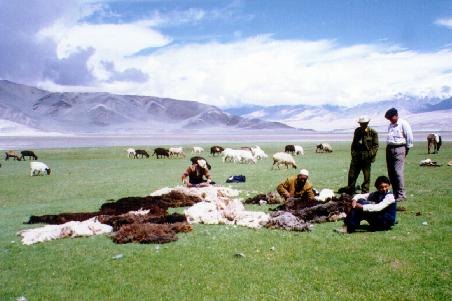
Pamir Range
Pamir means high pasturage and the Kyrgyz nomads herd sheep on the high plateau.
![]()
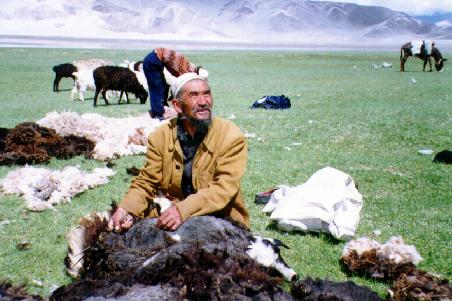
Pamir Range
Shearing is done with hand shears of course, electric clippers dont work up here!
![]()

Pamir Range
I had a herd of pedigreed Dorset sheep at one time so I was naturally interested in watching them do this. I found that their sheep were a lot more docile than mine had ever been. Or maybe they knew better than I did how to do it!
![]()

Pamir Range
I'm sure that the Kyrkyz children surrounded every day by such beautiful scenery don't even realize that its beautiful!
![]()
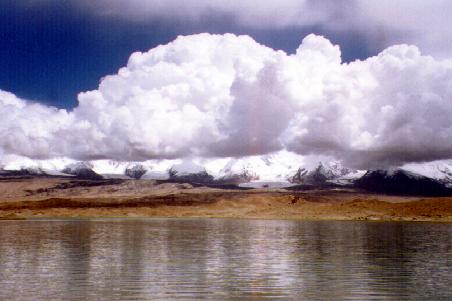
Pamir Range
Beautiful Kara Kul (Black Lake) with the 7546 meter Muztagh Ata (Father of Ice) mountain hiding behind the cloud. It just takes your breath away!
![]()
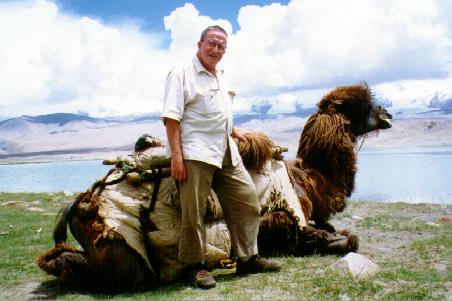
Pamir Range
Here's a happy tourist with camel by Kara Kul lake.
![]()
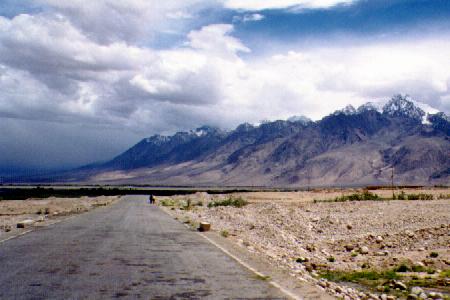
Pamir Range
The scenery changes at every turn becoming more dramatic as the road descends into the Tagh Arma basin leading to the Tashkurgan oasis.
![]()
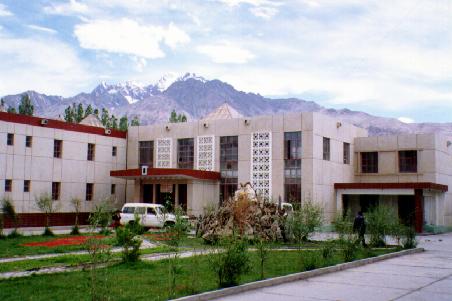
Tashkurgan
I had a room to myself for only 2 $US in Tashkurgan's Pamir Hotel. The room was OK but there was no restaurant so we ate round flat bread with grilled mutton and onions in streetside food stalls. It was great food but there was no beer.
![]()
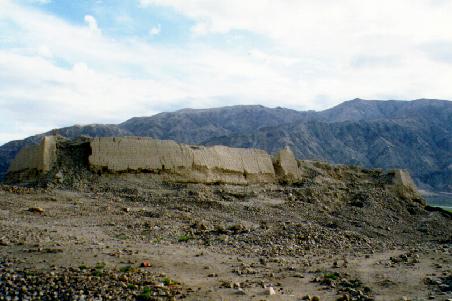
Tashkurgan
Tash Kurgan means stone fortress or city in Uighur. The Tashkurgan Oasis is strategically located close to the Mintaka and Kunjerab passes across the Pamir range to Taxila in the Peshawar valley (historically known as Gandhara), taken by Alexander the Great in the 4th century BC. The legend has it that some of Alexander's troops passed by Tashkurgan as they swept from Taxila through the Pamirs up to the Issik Kul area on a punitive expedition to stop raiding by Saka tribes (indo-European nomad tribes descended from the Sarmatians).
Ptolemy (90 - 168 AD), mentionned a Stone Citadel in this area as a strong point on the road to China. The original stone fort has dissapeared but this 600 year old mud brick fortress bears witness to its military role in the 14th century when this area was held by the Djaghatai mongols.
![]()
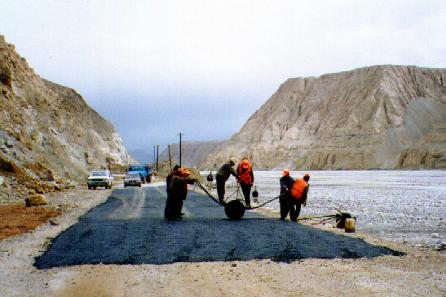
Pamir Range
We were held up on the way back to Kashgar by a six manpower steamroller!
![]()

Pamir Range
In the afternoon the weather turned bad in the mountains, it rained and the visibility fell to zero in a matter of minutes.
![]()
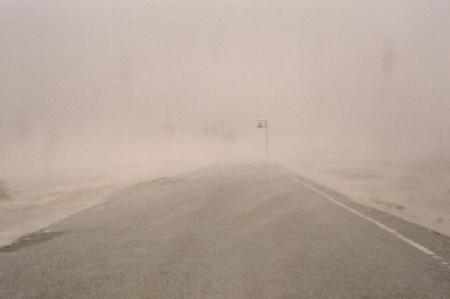
Taklamakan
To round off our two day jaunt we experienced a bit of a sand storm on the edge of the Taklamakan desert before reaching Kashgar. I stayed to see the Sunday Market and flew back to Urumqi where I watched the national celebrations for the return of Hong Kong to China before flying to Almaty in Kazakstan.